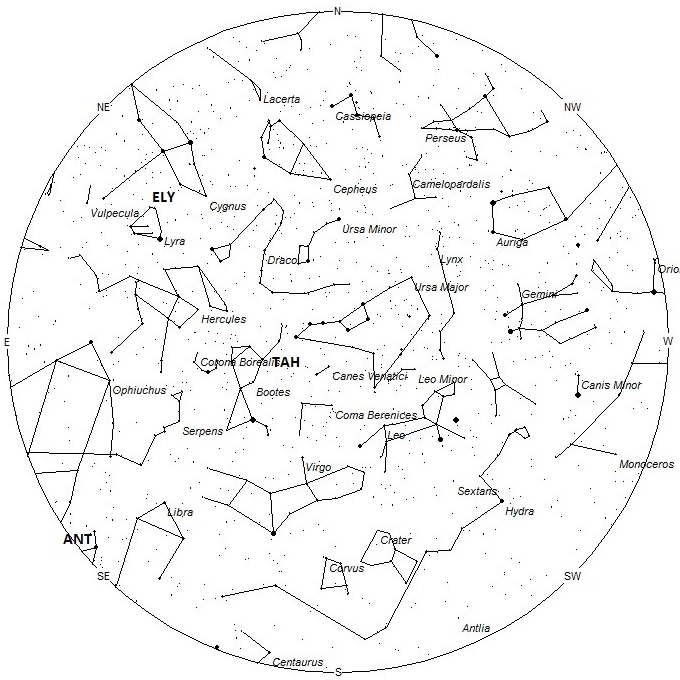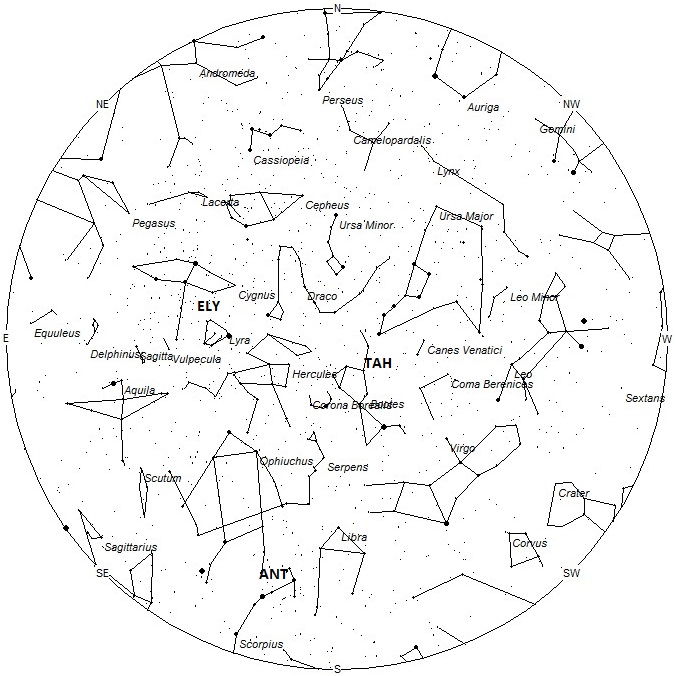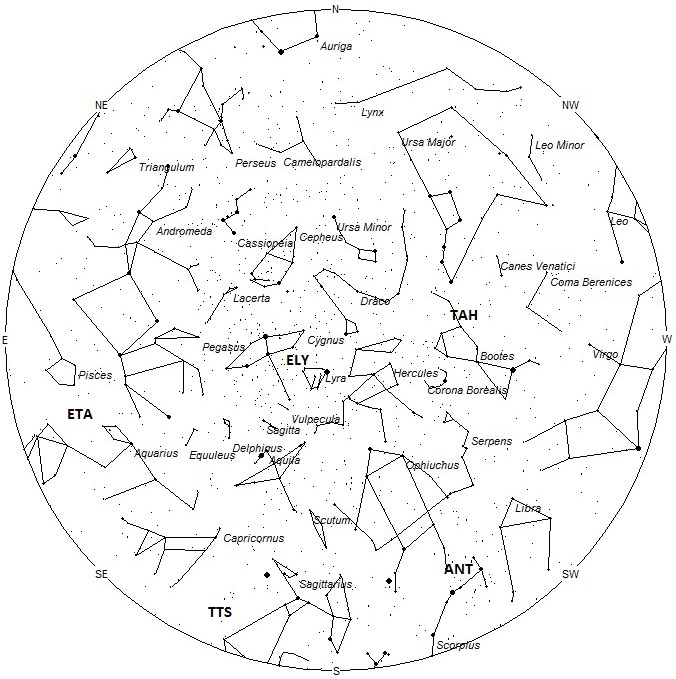During this period the moon reaches its first quarter phase on Saturday May 11th. At this time the half-illuminated moon is present in the evening sky and does not set until 3-4am as seen from mid-northern latitudes. As the week progresses the window of dark skies between moonset and dawn will shrink until it disappears by Wednesday May 15th. The estimated total hourly meteor rates for evening observers this week is near 2 for those viewing from the northern hemisphere and 3 for those located south of the equator. For morning observers the estimated total hourly rates should be near 11 as seen from mid-northern latitudes (45N) and 20 as seen from tropical southern locations (25S). The actual rates will also depend on factors such as personal light and motion perception, local weather conditions, alertness and experience in watching meteor activity. Evening rates are reduced by moonlight during this period. Note that the hourly rates listed below are estimates as viewed from dark sky sites away from urban light sources. Observers viewing from urban areas will see less activity as only the brightest meteors will be visible from such locations.
The radiant (the area of the sky where meteors appear to shoot from) positions and rates listed below are exact for Saturday night/Sunday morning May 11/12. These positions do not change greatly day to day so the listed coordinates may be used during this entire period. Most star atlases (available at science stores and planetariums) will provide maps with grid lines of the celestial coordinates so that you may find out exactly where these positions are located in the sky. A planisphere or computer planetarium program is also useful in showing the sky at any time of night on any date of the year. Activity from each radiant is best seen when it is positioned highest in the sky, either due north or south along the meridian, depending on your latitude. It must be remembered that meteor activity is rarely seen at the radiant position. Rather they shoot outwards from the radiant so it is best to center your field of view so that the radiant lies at the edge and not the center. Viewing there will allow you to easily trace the path of each meteor back to the radiant (if it is a shower member) or in another direction if it is a sporadic. Meteor activity is not seen from radiants that are located below the horizon. The positions below are listed in a west to east manner in order of right ascension (celestial longitude). The positions listed first are located further west therefore are accessible earlier in the night while those listed further down the list rise later in the night.
These sources of meteoric activity are expected to be active this week.
.
The tau Herculids (TAH) are an irregular shower not active every year. They are best known for being associated with comet Schwassmann-Wachmann 3 and the strong display seen in 1930. Due to recent activity from the comet, this shower could produce more activity in the upcoming decade. The Earth could start encountering particles from Schwassmann-Wachmann 3 around May 14. On that date the radiant would lie near 14:24 (216) +35. This area of the sky is located in western Bootes, 4 degrees southwest of the 3rd magnitude star known as Seginus (gamma Bootis). This is not that close to the star tau Herculis, for which this shower is named. Apparently the discoverers of this display placed the radiant further east toward Corona Borealis and Hercules. This area of the sky is best placed near midnight local summer time (LST), when it lies high overhead for observers located in mid-northern latitudes. With an entry velocity of 15 km/sec., the average tau Herculid meteor would be of very slow velocity.
The center of the large Anthelion (ANT) radiant is currently located at 16:12 (243) -22. This position lies in northwestern Scorpius, 2 degrees southeast of the 3rd magnitude star known as Acrab (beta Scorpii). Due to the large size of this radiant, Anthelion activity may also appear from eastern Libra, southern Ophiuchus as well as northwestern Scorpius. This radiant is best placed near 0200 LST, when it lies on the meridian and is located highest in the sky. Rates at this time should be near 2 per hour as seen from mid-northern latitudes (45 N) and 3 per hour as seen from the southern tropics (S 25) . With an entry velocity of 30 km/sec., the average Anthelion meteor would be of slow velocity.
The eta Lyrids (ELY) are active from May 6-13 with maximum activity occurring on the 11th. The radiant is currently located at 19:24 (291) +44. This area of the sky is located in northeastern Lyra, 4 degrees northeast of the 4th magnitude star known as eta Lyrae. This radiant is best placed during the last hour before dawn when it lies highest above the horizon in a dark sky. Current rates are expected to be 1 as seen from the northern hemisphere and less than 1 as seen from south of the equator. These meteors are not well seen from locations south of the equator as the radiant does not rise very high into the northern sky. With an entry velocity of 44 km/sec., the average meteor from this source would be of medium velocity.
The Theta2 Sagittariids (TTS) are a new discovery of the IMO video network using cameras located in Australia. These meteors are active from May 10-15, which maximum activity occurring on the 14th. At maximum the radiant lies near the position of 20:04 (301) -33. This area of the sky lies in a rather blank area of southeastern Sagittarius, 2 degrees north of the 4th magnitude star known as theta 2 Sagittarii. The radiant is best placed just before the break of dawn when the radiant lies highest in the sky. While Theta 2 Sagittariid meteors can be seen in both hemispheres, the south is favored as the radiant lies higher in their sky. Hourly rates are expected to be less than 1 no matter your location. At 67km/sec. the Theta 2 Sagittariids would produce meteors of swift velocity.
The eta Aquariids (ETA) are particles from Halley’s Comet, produced in Earth-crossing orbits many centuries ago. The radiant is currently located at 22:51 (343) +01. This area of the sky is located in eastern Aquarius, 3 degrees east of the 4th magnitude star known as eta Aquarii. The radiant does not rise until 2-3am local LDST so these meteors cannot be seen during the evening hours. The best time to view this activity is during the hour before the start of morning twilight, when the radiant lies highest in a dark sky. With the radiant low in the east it would be best to face halfway up in the sky in that same direction. Rates should be near 3 per hour as seen from mid-northern latitudes and 7 per hour as seen from the southern tropics. With an entry velocity of 66 kilometers per second, a majority of these meteors will appear to move swiftly with a high percentage of the bright meteors leaving persistent trains. Surprisingly, this shower produces very few fireballs.
As seen from the mid-northern hemisphere (45N) one would expect to see approximately 5 sporadic meteors per hour during the last hour before dawn as seen from rural observing sites. Evening rates would be near 1 per hour. As seen from the tropical southern latitudes (25S), morning rates would be near 9 per hour as seen from rural observing sites and 2 per hour during the evening hours. Locations between these two extremes would see activity between the listed figures. Evening rates are reduced due to bright moonlight.
The list below offers the information from above in tabular form. Rates and positions are exact for Saturday night/Sunday morning except where noted in the shower descriptions.
| SHOWER | DATE OF MAXIMUM ACTIVITY | CELESTIAL POSITION | ENTRY VELOCITY | CULMINATION | HOURLY RATE | CLASS |
| RA (RA in Deg.) DEC | Km/Sec | Local Summer Time | North-South | |||
| tau Herculids (TAH) | Jun 03 | 14:24 (216) +35 | 15 | 01:00 | <1 – <1 | III |
| Anthelions (ANT) | – | 16:12 (243) -22 | 30 | 02:00 | 2 – 3 | II |
| eta Lyrids (ELY) | May 11 | 19:24 (291) +44 | 44 | 05:00 | 1 – <1 | II |
| Theta2 Sagittariids | May 15 | 20:04 (301) -33 | 67 | 06:00 | <1 – <1 | II |
| eta Aquariids (ETA) | May 07 | 22:51 (343) +01 | 66 | 09:00 | 3 – 7 | I |




